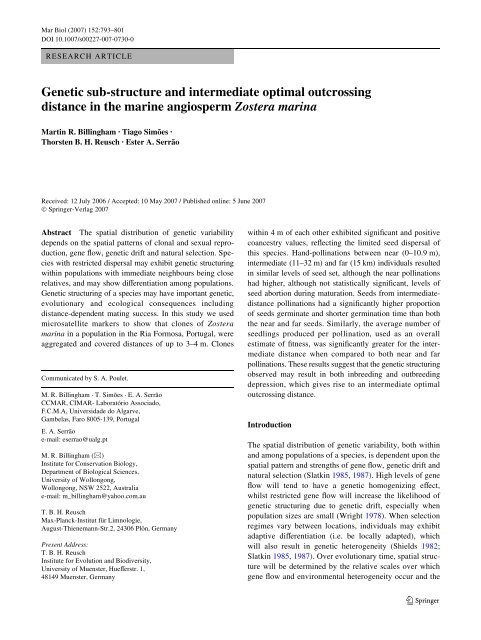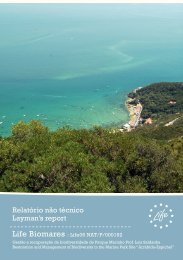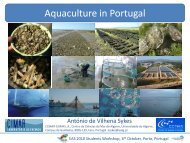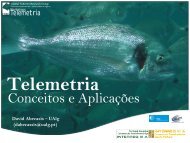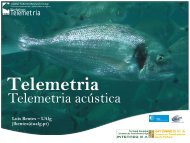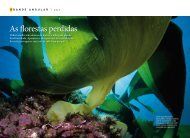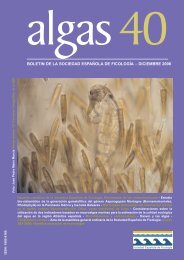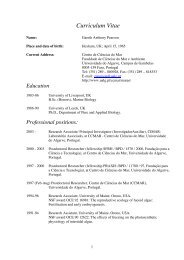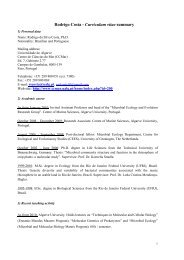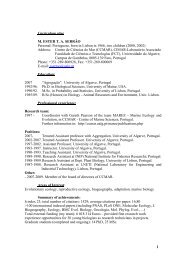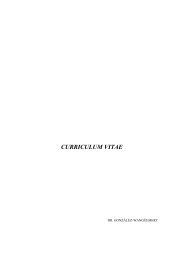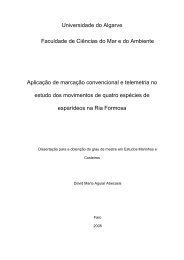Genetic sub-structure and intermediate optimal outcrossing distance ...
Genetic sub-structure and intermediate optimal outcrossing distance ...
Genetic sub-structure and intermediate optimal outcrossing distance ...
You also want an ePaper? Increase the reach of your titles
YUMPU automatically turns print PDFs into web optimized ePapers that Google loves.
Mar Biol (2007) 152:793–801<br />
DOI 10.1007/s00227-007-0730-0<br />
RESEARCH ARTICLE<br />
<strong>Genetic</strong> <strong>sub</strong>-<strong>structure</strong> <strong>and</strong> <strong>intermediate</strong> <strong>optimal</strong> <strong>outcrossing</strong><br />
<strong>distance</strong> in the marine angiosperm Zostera marina<br />
Martin R. Billingham · Tiago Simões ·<br />
Thorsten B. H. Reusch · Ester A. Serrão<br />
Received: 12 July 2006 / Accepted: 10 May 2007 / Published online: 5 June 2007<br />
© Springer-Verlag 2007<br />
Abstract The spatial distribution of genetic variability<br />
depends on the spatial patterns of clonal <strong>and</strong> sexual reproduction,<br />
gene Xow, genetic drift <strong>and</strong> natural selection. Species<br />
with restricted dispersal may exhibit genetic structuring<br />
within populations with immediate neighbours being close<br />
relatives, <strong>and</strong> may show diVerentiation among populations.<br />
<strong>Genetic</strong> structuring of a species may have important genetic,<br />
evolutionary <strong>and</strong> ecological consequences including<br />
<strong>distance</strong>-dependent mating success. In this study we used<br />
microsatellite markers to show that clones of Zostera<br />
marina in a population in the Ria Formosa, Portugal, were<br />
aggregated <strong>and</strong> covered <strong>distance</strong>s of up to 3–4 m. Clones<br />
Communicated by S. A. Poulet.<br />
M. R. Billingham · T. Simões · E. A. Serrão<br />
CCMAR, CIMAR- Laboratório Associado,<br />
F.C.M.A, Universidade do Algarve,<br />
Gambelas, Faro 8005-139, Portugal<br />
E. A. Serrão<br />
e-mail: eserrao@ualg.pt<br />
M. R. Billingham (&)<br />
Institute for Conservation Biology,<br />
Department of Biological Sciences,<br />
University of Wollongong,<br />
Wollongong, NSW 2522, Australia<br />
e-mail: m_billingham@yahoo.com.au<br />
T. B. H. Reusch<br />
Max-Planck-Institut für Limnologie,<br />
August-Thienemann-Str.2, 24306 Plön, Germany<br />
Present Address:<br />
T. B. H. Reusch<br />
Institute for Evolution <strong>and</strong> Biodiversity,<br />
University of Muenster, HueVerstr. 1,<br />
48149 Muenster, Germany<br />
within 4 m of each other exhibited signiWcant <strong>and</strong> positive<br />
coancestry values, reXecting the limited seed dispersal of<br />
this species. H<strong>and</strong>-pollinations between near (0–10.9 m),<br />
<strong>intermediate</strong> (11–32 m) <strong>and</strong> far (15 km) individuals resulted<br />
in similar levels of seed set, although the near pollinations<br />
had higher, although not statistically signiWcant, levels of<br />
seed abortion during maturation. Seeds from <strong>intermediate</strong><strong>distance</strong><br />
pollinations had a signiWcantly higher proportion<br />
of seeds germinate <strong>and</strong> shorter germination time than both<br />
the near <strong>and</strong> far seeds. Similarly, the average number of<br />
seedlings produced per pollination, used as an overall<br />
estimate of Wtness, was signiWcantly greater for the <strong>intermediate</strong><br />
<strong>distance</strong> when compared to both near <strong>and</strong> far<br />
pollinations. These results suggest that the genetic structuring<br />
observed may result in both inbreeding <strong>and</strong> outbreeding<br />
depression, which gives rise to an <strong>intermediate</strong> <strong>optimal</strong><br />
<strong>outcrossing</strong> <strong>distance</strong>.<br />
Introduction<br />
The spatial distribution of genetic variability, both within<br />
<strong>and</strong> among populations of a species, is dependent upon the<br />
spatial pattern <strong>and</strong> strengths of gene Xow, genetic drift <strong>and</strong><br />
natural selection (Slatkin 1985, 1987). High levels of gene<br />
Xow will tend to have a genetic homogenizing eVect,<br />
whilst restricted gene Xow will increase the likelihood of<br />
genetic structuring due to genetic drift, especially when<br />
population sizes are small (Wright 1978). When selection<br />
regimes vary between locations, individuals may exhibit<br />
adaptive diVerentiation (i.e. be locally adapted), which<br />
will also result in genetic heterogeneity (Shields 1982;<br />
Slatkin 1985, 1987). Over evolutionary time, spatial <strong>structure</strong><br />
will be determined by the relative scales over which<br />
gene Xow <strong>and</strong> environmental heterogeneity occur <strong>and</strong> the<br />
123
794 Mar Biol (2007) 152:793–801<br />
intensity at which selection is operating (Jain <strong>and</strong> Bradshaw<br />
1966; Endler 1977).<br />
<strong>Genetic</strong> diVerentiation within <strong>and</strong> among plant populations<br />
has been shown to be dependent upon the dispersal<br />
capacity of the species (e.g. Hamrick <strong>and</strong> Godt 1996),<br />
although ecological factors such as breeding system, phenology<br />
<strong>and</strong> Xoral morphology are also likely to be important<br />
(Loveless <strong>and</strong> Hamrick 1984; Bush <strong>and</strong> Smouse 1992).<br />
Species ranging from aquatic plants, to ferns <strong>and</strong> forest<br />
trees may exhibit within-population genetic <strong>structure</strong>, with<br />
the extent often depending upon their dispersal mechanisms<br />
(e.g. Levin <strong>and</strong> Kerster 1974; Nason et al. 1997). However,<br />
genetic structuring within plant populations is not ubiquitous<br />
(Kudoh <strong>and</strong> Whigman 1997) <strong>and</strong> in some cases this<br />
may be directly attributable to high levels of gene Xow (e.g.<br />
Leonardi et al. 1996). Furthermore, levels of among-population<br />
diVerentiation have been shown to be dependent<br />
upon seed dispersal <strong>distance</strong>s, where species with restricted<br />
seed dispersal typically exhibit higher population diVerentiation<br />
(Loveless <strong>and</strong> Hamrick 1984).<br />
<strong>Genetic</strong> structuring of a species can have important evolutionary<br />
consequences. In <strong>structure</strong>d populations restricted<br />
pollen dispersal will result in self or genetically related pollen<br />
reaching a stigma (Levin <strong>and</strong> Kerster 1974). In many<br />
plant species this related pollen may then be rejected due to<br />
a self-incompatibility (SI) system, in which pollen growth<br />
is arrested on the stigma, in the style or during early<br />
embryo development (de Nettancourt 1977; Charlesworth<br />
<strong>and</strong> Charlesworth 1987). In addition, progeny from selfed<br />
or near neighbour pollinations may exhibit relatively low<br />
Wtness, or so-called inbreeding depression (Price <strong>and</strong> Waser<br />
1979; Falconer 1981; Charlesworth <strong>and</strong> Charlesworth<br />
1987; Busch 2005). Inbreeding depression may be manifested<br />
as smaller or fewer seed per pollination (or even<br />
embryo abortion, which makes it diYcult to distinguish<br />
between late acting SI <strong>and</strong> early acting inbreeding depression;<br />
Seavey <strong>and</strong> Bawa 1986; Waser 1993) poor seed germination,<br />
<strong>and</strong> reduced adult size, survival <strong>and</strong> fertility<br />
(Charlesworth <strong>and</strong> Charlesworth 1987).<br />
At the other end of the scale, reduced seed set <strong>and</strong><br />
oVspring Wtness may also result when pollen moves over<br />
relatively large <strong>distance</strong>s so that genetically dissimilar pollen<br />
is deposited on stigmas, although this phenomenon has<br />
been the focus of much less attention than near neighbour<br />
pollinations (Waser 1993). Reduced fertilization of long<br />
<strong>distance</strong> pollen is possible if fertilization is under multilocus<br />
control, as suggested by the presence of pseudoincompatibility<br />
(in which successful selfed pollinations are<br />
relatively few, although not zero) <strong>and</strong> continuous variation<br />
in responses of individuals (e.g. seed production; Waser<br />
1993). Similarly, long <strong>distance</strong> pollinations may give rise<br />
to outbreeding depression, where progeny from crosses<br />
between distant individuals have reduced Wtness (Price <strong>and</strong><br />
123<br />
Waser 1979; Shields 1982). Outbreeding depression may<br />
result when selection has lead to localized adaptation <strong>and</strong><br />
therefore spatial diVerentiation of genotypes. Crosses<br />
between environments therefore lead to the dilution of<br />
advantageous alleles (Endler 1977; Price <strong>and</strong> Waser 1979;<br />
Shields 1982). Alternatively, outbreeding depression may<br />
result from the disruption, by recombination, of co-adapted<br />
gene complexes or other genetic mechanisms such as epistasis<br />
(Price <strong>and</strong> Waser 1979; Shields 1982; Waser 1993).<br />
If seed set or relative Wtness are reduced for short <strong>and</strong><br />
long <strong>distance</strong> pollinations, <strong>intermediate</strong> <strong>distance</strong> pollinations<br />
will result in the best performance. In these cases an<br />
<strong>intermediate</strong> <strong>optimal</strong> <strong>outcrossing</strong> <strong>distance</strong> results for gamete<br />
receptivity <strong>and</strong>/or oVspring Wtness (Waser 1993). Intermediate<br />
<strong>optimal</strong> <strong>outcrossing</strong> <strong>distance</strong>s have been observed in a<br />
number of plant species (e.g. Price <strong>and</strong> Waser 1979; Waser<br />
<strong>and</strong> Price 1989, 1994; Stacy 2001; Willi <strong>and</strong> van Buskirk<br />
2005). However, in some cases an <strong>intermediate</strong> optimum<br />
has not been observed (e.g. Fenster 1991; Hauser <strong>and</strong> Loeschcke<br />
1994) even though outbreeding depression has been<br />
identiWed (Waser <strong>and</strong> Price 1994; Heiser <strong>and</strong> Shaw 2006).<br />
Zostera marina L. is a seagrass (marine angiosperm) that<br />
reproduces both vegetatively (via the clonal lateral spread<br />
of rhizomes) <strong>and</strong> sexually through seeds (den Hartog 1970;<br />
Phillips <strong>and</strong> Meñez 1988). Reproductive shoots contain<br />
branches (rhipidia) which produce numerous inXorescences<br />
(spathes) in which male <strong>and</strong> female Xowering is asynchronous<br />
(protogynous) <strong>and</strong> therefore likely to reduce within<br />
spathe selWng (de Cock 1980). Controlled pollinations have<br />
shown Z. marina to be self-compatible (Ruckelhaus 1995;<br />
Hämmerli <strong>and</strong> Reusch 2003a). Pollination is <strong>sub</strong>aqueous<br />
(de Cock 1980; Cox et al. 1992) <strong>and</strong> 75% of the pollen has<br />
been shown to travel less than 6 m (Ruckelhaus 1996).<br />
Seed maturation takes 4–5 weeks (de Cock 1980) with Weld<br />
observations showing seed dispersal to be restricted to<br />
mostly less than 2 m (Orth et al. 1994; Ruckelhaus 1996).<br />
In the Ria Formosa, Portugal (near the species southern<br />
European limit) meadows of Z. marina occupy continuous<br />
patches, which grow in muddy <strong>sub</strong>strates <strong>and</strong> extend from<br />
the low intertidal to depths of 6 m in this tidal lagoon system<br />
(Billingham et al. 2003).<br />
<strong>Genetic</strong> analyses have shown that clonal growth <strong>and</strong><br />
restricted dispersal of both pollen <strong>and</strong> seed in Z. marina<br />
results in genetic structuring within populations (e.g. Ruckelhaus<br />
1998; Hämmerli <strong>and</strong> Reusch 2003b; Rhode <strong>and</strong><br />
DuVy 2004). For example, Hämmerli <strong>and</strong> Reusch (2003b)<br />
used microsatellite markers to show that for two Baltic Sea<br />
populations clones generally covered <strong>distance</strong>s of 2–4 m,<br />
with some results suggesting signiWcant biparental genetic<br />
relatedness (coancestry) between samples collected from<br />
6–10 m. Restricted dispersal in Z. marina has also led to<br />
high levels of among population genetic diVerentiation<br />
(Reusch et al. 2000; Reusch 2002), with the highest levels
Mar Biol (2007) 152:793–801 795<br />
reported being an F ST of 0.233 over 15 km, near the species<br />
southern distributional limit in the eastern Atlantic, in the<br />
Ria Formosa, Portugal (Billingham et al. 2003).<br />
The aims of this study of Z. marina in the Ria Formosa,<br />
Portugal were to examine; (1) the genetic <strong>structure</strong> within a<br />
population using microsatellite markers <strong>and</strong> (2) the eVect of<br />
pollination <strong>distance</strong> (up to 15 km) on fertilization success<br />
<strong>and</strong> seed germination.<br />
Materials <strong>and</strong> methods<br />
<strong>Genetic</strong> <strong>structure</strong><br />
Sample collection was conducted in the Ria Formosa, Portugal<br />
to examine gene Xow among sites as described in<br />
detail in Billingham et al. (2003). As part of that study, 39<br />
samples were collected from the Esteiro Baião site, an<br />
almost continuous patch of Z. marina, which covered an<br />
area of »12 £ 35 m 2 from the low intertidal to 2 m depth.<br />
When samples were collected the sample position was<br />
recorded, using two measuring tapes separated by a Wxed<br />
<strong>distance</strong> (along the “base-line”), so that XY co-ordinates<br />
could be determined. Sampling involved collecting vegetative<br />
shoots from the seagrass “carpet” <strong>and</strong> dissecting the<br />
basal 2–3 cm of meristematic tissue. Samples were <strong>sub</strong>sequently<br />
freeze-dried pending microsatellite analysis.<br />
The DNA extraction, microsatellite characterization <strong>and</strong><br />
locus scoring followed the procedures of Reusch et al.<br />
(1999, 2000). In brief, DNA was extracted from 0.02 to<br />
0.05 g of dried plant tissue using Qiagen plant extraction<br />
kits (Dneasy, Qiagen, Hilden, Germany). Individuals were<br />
genotyped, using Xuorescently labelled PCR products on a<br />
Applied Biosystems 3100 automated sequencer, at nine<br />
microsatellite loci, which had previously been shown to be<br />
highly polymorphic (GenBank accession numbers:<br />
AJ009899, -901, 902, 905 <strong>and</strong> AJ249303-307; Reusch et al.<br />
1999, 2000; Reusch 2000).<br />
To test for the likelihood of shared multi-locus genotypes<br />
arising from sexual reproduction we used the method<br />
of Arnaud-Haond <strong>and</strong> Belkhir (2007). Multilocus autocorrelation<br />
analyses (SPAGeDi; Hardy <strong>and</strong> Vekemans<br />
2002; using the coancestry of Loiselle et al. 1995) were<br />
employed, using the genotypes of all samples as well as<br />
only the unique genotypes (Reusch et al. 1999). To distinguish<br />
between genetic structuring due to clonal spread <strong>and</strong><br />
restricted seed dispersal, all sampled genotypes were analysed<br />
using pair-wise comparisons which were divided into<br />
two <strong>distance</strong> categories, less than 11 m <strong>and</strong> greater than<br />
11 m. Eleven metres was chosen as the cut oV point as previous<br />
studies have indicated high levels of genetic relatedness<br />
over similar scales in Z. marina (Ruckelhaus 1996;<br />
Hämmerli <strong>and</strong> Reusch 2003b, c) <strong>and</strong> because in this study<br />
approximately half of the h<strong>and</strong>-pollinations from the Esteiro<br />
Baião site were within this <strong>distance</strong> (see next section).<br />
In order to examine genetic structuring due only to<br />
restricted seed dispersal, the unique multi-locus genotypes<br />
were analysed using the centre of a clone as the coordinate<br />
in the autocorrelation analysis (Hämmerli <strong>and</strong> Reusch<br />
2003b; Alberto et al. 2005). As seed dispersal in Z. marina<br />
has been shown to be generally less than 2 m (Orth et al.<br />
1994; Ruckelhaus 1996), autocorrelation analysis was conducted<br />
using Wve <strong>distance</strong> categories chosen to have similar<br />
numbers of pair-wise comparisons. For all autocorrelation<br />
analyses, 95% conWdence intervals around the coancestries<br />
were determined using permutation tests re-sampling 1,000<br />
times (Hardy <strong>and</strong> Vekemans 2002).<br />
Pollinations<br />
H<strong>and</strong>-pollinations were carried out in Wltered seawater<br />
in Xow-through tanks at the Universidade do Algarve,<br />
Ramalhete Weld station situated near the Ria Formosa, Portugal.<br />
Six Xow-through tanks were used in the experiments.<br />
For each plant to be used in the experiment, <strong>distance</strong> measurements<br />
were taken from two Wxed points in order to map<br />
the collected plants <strong>and</strong> enable <strong>distance</strong>s between plants to<br />
be determined. All pollen recipient plants were collected<br />
using SCUBA or snorkel from the Esteiro Baião population<br />
(37°01�N, 7°59�W; see Billingham et al. 2003 for a map)<br />
between February <strong>and</strong> April, 2003 with pollinations taking<br />
place between 4 March <strong>and</strong> 20 May, which covered most of<br />
the Xowering season. Pollen recipients were maintained in<br />
individual plastic pots of 17 cm diameter <strong>and</strong> 17 cm depth<br />
within three of the Xow-through tanks. When collecting pollen<br />
recipients, as much rhizome as possible was extracted<br />
before being placed in the pot <strong>and</strong> covered with sediment<br />
<strong>and</strong> a thin layer of s<strong>and</strong>. In total, 36 plants were collected<br />
for use as pollen recipients of which 27 produced Xowers<br />
able to be pollinated. The number of pollinations per pollen<br />
recipient ranged from 1 to 13 (mean 6.48 § 0.80 SE).<br />
Pollen donor plants were also collected throughout the<br />
course of the experiment. Pollen donors from the Esteiro<br />
Baião population were mapped in the same fashion as pollen<br />
recipient plants in order to determine the pollination<br />
<strong>distance</strong>s. Long-<strong>distance</strong> pollen donors, all regarded as<br />
coming from 15 km away, were collected by SCUBA diving<br />
at Ponta da Culatra (PCU <strong>and</strong> PCM sites in Billingham<br />
et al. 2003) located at 37°00�N, 7°49�W. Relatively large<br />
<strong>distance</strong>s (10–20 m), or s<strong>and</strong>, separated all collected individuals<br />
in order to maximize the number of genotypes<br />
included in the experiment (i.e. to reduce re-sampling of<br />
clones). For the pollen donors only as much rhizome as<br />
would easily come loose was collected. Donors were maintained<br />
with Wve plants per pot, <strong>and</strong> those from Esteiro Baião<br />
<strong>and</strong> Ponta da Culatra were kept in diVerent Xow-through<br />
123
796 Mar Biol (2007) 152:793–801<br />
tanks. In total, 49 pollen donors were collected from<br />
the mapped Esteiro Baião site <strong>and</strong> 55 from the Ponta da<br />
Culatra. Twenty-four pollen donors were used from Esteiro<br />
Baião, with the number of pollinations ranging from 1 to 13<br />
(mean 4.38 § 0.69 SE), whilst 21 Ponta da Culatra pollen<br />
donors were used with the number of pollinations ranging<br />
from 1 to 13 (mean 3.33 § 0.63 SE).<br />
Pollen recipients were monitored daily to assess individual<br />
inXorescence maturity. One or two days before the inXorescences<br />
were mature (i.e. ready to open), 0.3 mm mesh<br />
bags were gently tied around them to prevent pollen from<br />
other pollen recipients in the same tank from fertilizing<br />
the female Xowers when they opened (Ruckelhaus 1995;<br />
Rhode <strong>and</strong> DuVy 2004). The pollen to be used (from a pollen<br />
donor with mature male Xowers releasing pollen) was<br />
collected using a pasteur pipette <strong>and</strong> transferred to a clean<br />
glass Petri dish containing Wltered seawater. The inXorescence<br />
to be pollinated (still attached to the plant) was then<br />
removed from the tank <strong>and</strong> the mesh bag removed. The<br />
inXorescence was then immersed in the Petri dish for about<br />
30 s <strong>and</strong> moved through the Wliform pollen so that the<br />
pollen contacted <strong>and</strong> attached to the stigmas. At this time<br />
the number of female Xowers in the inXorescence with<br />
extended stigmas was counted <strong>and</strong> recorded. Finally, the<br />
mesh bag was once again placed on the inXorescence <strong>and</strong><br />
the plant returned to the tank. Each pollination was labelled<br />
with a marked piece of masking tape.<br />
After the male phase of Xowering had Wnished within<br />
each h<strong>and</strong>-pollinated inXorescence, the mesh bag was<br />
removed. (Note that due to the asynchrony of the female <strong>and</strong><br />
male Xowers, it was very unlikely that males from within an<br />
inXorescence could pollinate female Xowers of the same<br />
inXorescence.) During the following 3 weeks each h<strong>and</strong>pollinated<br />
inXorescence was monitored to determine how<br />
many seeds were developing. When seeds were nearly<br />
mature <strong>and</strong> ready for release (5–6 weeks) 0.3 mm mesh<br />
bags were once again placed on the inXorescences to capture<br />
the released seeds. Following seed release the mesh bags<br />
containing the seeds were stored in one of the Xow-through<br />
tanks (Phillips et al. 1983; Moore et al. 1993). In total, 181<br />
inXorescences were h<strong>and</strong>-pollinated, although six were accidentally<br />
broken <strong>and</strong> were not included in the analyses.<br />
Pollinations from the three diVerent <strong>distance</strong> categories<br />
of 0–10.9 m, 11–32 m <strong>and</strong> 15 km (i.e. “near”, “<strong>intermediate</strong>”<br />
<strong>and</strong> “far”, respectively) continued throughout the<br />
experiment to minimize any temporal eVects. When pollinations<br />
were analysed as four approximately equal time<br />
periods during the experiment (i.e. early late), no statistical<br />
diVerence was found among the number of pollinations<br />
from the diVerent <strong>distance</strong> categories (� 2 test, P > 0.15)<br />
indicating that temporal eVects could be ignored. Similarly,<br />
no signiWcant correlation between the number of female<br />
Xowers pollinated in each inXorescence <strong>and</strong> the number of<br />
123<br />
seeds forming was found (r 2 = 0.023, P > 0.90), so the<br />
number of female Xowers pollinated was not included in<br />
the analyses. In addition, there was no statistical diVerence<br />
between the numbers of stigmas per pollination among the<br />
<strong>distance</strong> classes (P >0.80).<br />
After all seeds had matured the mass of each seed was<br />
measured. Then, in order to assess germination, seeds were<br />
placed in 10‰ seawater <strong>and</strong> kept at 15°C; conditions<br />
thought to induce germination in this species (Phillips et al.<br />
1983; Hootsmans et al. 1987; Moore et al. 1993). Individual<br />
seeds were followed by placing them in wells of 96 well<br />
PCR micro-plates, which were then kept in a plastic container<br />
with the aerated seawater. The plastic container was<br />
maintained in a 700 EDTU Fitoclima (ARALAB, Oeiras,<br />
Portugal) with 80 �mol photons m ¡2 s ¡1 light intensity <strong>and</strong><br />
a 14 h:10 h day/night photoperiod. The Wltered seawater<br />
was changed weekly. The occurrence of germination, <strong>and</strong><br />
number of days to germination, were recorded for 1 month.<br />
For statistical analyses the data were analysed as three<br />
<strong>distance</strong> categories; near (0–10.9 m), <strong>intermediate</strong> (11–<br />
32 m) <strong>and</strong> far (15 km). Comparisons of proportions (i.e.<br />
pollination <strong>and</strong> germination success as well as the average<br />
number of seedlings produced per pollination- used as a<br />
measure of overall Wtness) were tested using the normal<br />
approximation to the binomial test (Zar 1999). Comparisons<br />
of measures (i.e. seed mass <strong>and</strong> time to germination) were<br />
analysed with ANOVA’s <strong>and</strong> post hoc pair-wise t-tests<br />
using SigmaPlot, Version 6.00, SPSS, Chicago, IL, USA.<br />
Results<br />
All repetitions of multilocus genotypes had P
Mar Biol (2007) 152:793–801 797<br />
G G<br />
G<br />
G<br />
F F<br />
A A<br />
A A<br />
G<br />
F<br />
F<br />
I*<br />
R<br />
Q<br />
K<br />
B<br />
E<br />
H<br />
L M<br />
D C<br />
B B<br />
B H<br />
J<br />
I*<br />
M<br />
P<br />
Fig. 1 Map showing the within site clonal structuring at Esteiro<br />
Baião. Letters indicate the diVerent clones that were detected. Letters<br />
enclosed within a shape indicate those clones that were represented by<br />
more than one sample. Letters marked with an asterisk indicate samples<br />
of the same clone that were not adjacent (I <strong>and</strong> N)<br />
chance indicating that seeds are typically dispersed over a<br />
<strong>distance</strong> less than 4 m (F ij = +0.051, P < 0.01). At <strong>distance</strong>s<br />
greater than 3.5 m no statistical diVerences from r<strong>and</strong>om<br />
expectations were observed (Fig. 3).<br />
Near pollinations had the highest incidence of seed<br />
forming at 3 weeks, although by 6 weeks the far pollinations<br />
had the highest proportion of set seed <strong>and</strong> <strong>intermediate</strong><br />
pollinations the lowest (Fig. 4). This change was due to<br />
the higher rate of abortion of seeds in the near pollinations<br />
compared to the <strong>intermediate</strong> <strong>and</strong> far pollinations. However,<br />
none of these trends were statistically signiWcant<br />
(P < 0.1), which could be due to insuYcient sample sizes to<br />
detect such small diVerences.<br />
Seed mass varied signiWcantly among <strong>distance</strong>s (F =3.41,<br />
df =2, P
798 Mar Biol (2007) 152:793–801<br />
t<br />
e<br />
S<br />
d<br />
e<br />
e<br />
S<br />
0.4<br />
0.3<br />
0.2<br />
0.1<br />
0<br />
Fig. 4 Proportion of pollinations that formed seed versus pollination<br />
<strong>distance</strong>. Hatched bars indicate the proportion forming seed after<br />
3weeks, white bars indicate the proportion that produced mature seed<br />
at »6 weeks. Error bars indicate one SE. No statistical diVerences<br />
were detected (P >0.05)<br />
)<br />
g<br />
m<br />
(<br />
s<br />
s<br />
a<br />
M<br />
d<br />
e<br />
e<br />
S<br />
8<br />
6<br />
4<br />
2<br />
0<br />
limited dispersal of seeds. Multiply sampled clones covered<br />
<strong>distance</strong>s of 3–4 m (4–20 m 2 ), similar to clone sizes identi-<br />
Wed in other populations of Z. marina. For example, two<br />
populations from the Baltic Sea had clones generally<br />
smaller than 7 m 2 (Reusch et al. 1999; Hämmerli <strong>and</strong><br />
Reusch 2003b, c), although some clones up to 32 m 2 were<br />
identiWed (Hämmerli <strong>and</strong> Reusch 2003c). Furthermore, our<br />
inference that most seeds disperse less than 4 m agrees with<br />
the 2–4 m found by Hämmerli <strong>and</strong> Reusch (2003b), <strong>and</strong><br />
with direct observations (Orth et al. 1994; Ruckelhaus<br />
1996). Clonal <strong>structure</strong> at the Esteiro Baião site was typical<br />
of the Ria Formosa, in which analyses showed clones to be<br />
aggregated (with no intermingling of clones) with the largest<br />
clone occupying »500 m 2 (M. R. Billingham, unpublished<br />
data).<br />
123<br />
Near<br />
ab<br />
Near<br />
Intermediate<br />
Distance<br />
Fig. 5 Mass of individual seeds versus pollination <strong>distance</strong>. Error<br />
bars indicate one SE. DiVerent letters indicate statistical diVerences at<br />
P < 0.1 (i.e. not signiWcant at P < 0.05 level)<br />
a<br />
Intermediate<br />
Distance<br />
Far<br />
Far<br />
b<br />
)<br />
s<br />
y<br />
a<br />
D<br />
(<br />
n<br />
o<br />
i<br />
t<br />
a<br />
n<br />
i<br />
m<br />
r<br />
e<br />
G<br />
o<br />
t<br />
e<br />
m<br />
i<br />
T<br />
20<br />
15<br />
10<br />
5<br />
0<br />
a<br />
Near<br />
Intermediate<br />
Distance<br />
Fig. 6 Time to germination of the seeds versus pollination <strong>distance</strong>.<br />
Error bars indicate one SE. DiVerent letters indicate statistical diVerences<br />
at P
Mar Biol (2007) 152:793–801 799<br />
n<br />
o<br />
i<br />
t<br />
a<br />
n<br />
i<br />
l<br />
l<br />
o<br />
p<br />
r<br />
e<br />
p<br />
s<br />
g<br />
n<br />
i<br />
l<br />
d<br />
e<br />
e<br />
s<br />
f<br />
o<br />
r<br />
e<br />
b<br />
m<br />
u<br />
N<br />
0.6<br />
0.5<br />
0.4<br />
0.3<br />
0.2<br />
0.1<br />
0<br />
Near<br />
b<br />
Fig. 8 Number of seedlings produced per pollination (used as an overall<br />
measure of Wtness) versus pollination <strong>distance</strong>. Error bars indicate<br />
one SE. DiVerent letters indicate statistical diVerences at P
800 Mar Biol (2007) 152:793–801<br />
<strong>and</strong> 3 <strong>and</strong> 10 m pollinations had higher overall Wtnesses<br />
than 1 <strong>and</strong> 30 m pollinations (Waser 1987; Waser <strong>and</strong> Price<br />
1989, 1994). In addition to inbreeding depression, several<br />
studies relating genetic <strong>structure</strong> to <strong>outcrossing</strong> <strong>distance</strong><br />
have found reduced Wtness for the longest <strong>outcrossing</strong> <strong>distance</strong>s<br />
for at least some Wtness measures (e.g. Waser <strong>and</strong><br />
Price 1989, 1994; <strong>and</strong> reviewed in Waser 1993).<br />
Inbreeding <strong>and</strong> outbreeding depression in this study indicate<br />
that strong genetic eVects operate in the Ria Formosa<br />
Z. marina. These diVerences were detectable in experiments<br />
conducted over one Xowering season, due to the<br />
large magnitude of Wtness diVerentials between <strong>intermediate</strong><br />
pollinations <strong>and</strong> the near <strong>and</strong> far pollinations. Such<br />
diVerences most likely reXected the high level of genetic<br />
diVerentiation within <strong>and</strong> among Z. marina populations of<br />
the Ria Formosa. Consequently, these Wtness diVerences<br />
may represent the extreme as the study population was at<br />
the species geographical limit. Studying the eVects of pollination<br />
<strong>distance</strong> on Wtness parameters in populations <strong>and</strong><br />
species with lower levels of genetic diVerentiation might<br />
give diVerent results.<br />
Acknowledgements We thank S. Lopes, C. B. Capela <strong>and</strong> A. L.<br />
Quaresma at the Parque Natural de Ria Formosa for boat logistics.<br />
Thanks also to A. Hämmerli <strong>and</strong> C. Perrin for comments on an earlier<br />
version of the manuscript. This work was supported by FCT (Portugal)<br />
<strong>and</strong> ESF (European Social Fund) fellowships to MRB, the EU project<br />
EVK3-CT-2000-00044–Monitoring <strong>and</strong> Management of European<br />
Seagrass Beds (M&MS) <strong>and</strong> the FCT (Portugal) project PNAT/1999/<br />
BIA/15003/C <strong>and</strong> complies with the current laws in Portugal.<br />
References<br />
Alberto F, Gouveia L, Arnaud-Haond S, Pérez-Lloréns JL, Duarte CM,<br />
Serrão EA (2005) Within-population spatial genetic <strong>structure</strong>,<br />
neighbourhood size <strong>and</strong> clonal <strong>sub</strong>range in the seagrass Cymodocea<br />
nodosa. Mol Ecol 14:2669–2681<br />
Arnaud-Haond S, Belkhir K (2007) GENECLONE: a computer program<br />
to analyse genotypic data, test for clonality <strong>and</strong> describe<br />
spatial clonal organization. Mol Ecol Notes 7:15–17<br />
Billingham MR, Reusch TBH, Alberto F, Serrão EA (2003) Is asexual<br />
reproduction more important at geographical limits? A genetic<br />
study of the seagrass Zostera marina in the Ria Formosa, Portugal.<br />
Mar Ecol Prog Ser 265:77–83<br />
Busch JW (2005) Inbreeding depression in self-compatible <strong>and</strong> selfincompatible<br />
populations of Leavenworthia alabamica. Heredity<br />
94:159–165<br />
Bush RM, Smouse PE (1992) Evidence for adaptive signiWcance of<br />
allozymes in forest trees. New Forests 6:179–196<br />
Charlesworth D, Charlesworth B (1987) Inbreeding depression <strong>and</strong> its<br />
evolutionary consequences. Annu Rev Ecol Syst 18:237–268<br />
Cox PA, Laushman R, Ruckelhaus M (1992) Surface <strong>and</strong> <strong>sub</strong>marine<br />
pollination in the seagrass Zostera marina L. Biol J Linn Soc<br />
Lond 109:281–291<br />
de Cock AWAM (1980) Flowering, pollination <strong>and</strong> fruiting in Zostera<br />
marina L. Aquat Bot 9:201–220<br />
de Nettancourt D (1977) Incompatibility in angiosperms. Sex Plant<br />
Reprod 10:185–199<br />
123<br />
den Hartog C (1970) The seagrasses of the world. Verh<strong>and</strong>elingen<br />
Koninklijk Nederl<strong>and</strong>s Akademie Wetenschapen Afdeling Natuurkundle<br />
II 59:1–275<br />
Endler JA (1977) Geographic variation, speciation, <strong>and</strong> clines. Princeton<br />
University Press, Princeton<br />
Falconer DS (1981) Introduction to quantitative genetics, 2nd edn.<br />
Longman, London<br />
Fenster CB (1991) EVect of male pollen donor <strong>and</strong> female seed parent<br />
on allocation of resources to developing seeds <strong>and</strong> fruit in Chamaecrista<br />
fasciculata (Leguminosae). Am J Bot 78:13–23<br />
Hämmerli A, Reusch TBH (2002) Local adaptation <strong>and</strong> transplant<br />
dominance in genets of the marine clonal plant Zostera marina.<br />
Mar Ecol Prog Ser 242:111–118<br />
Hämmerli A, Reusch TBH (2003a) Flexible mating: cross-pollination<br />
aVects sex-expression in a marine clonal plant. J Evol Biol<br />
16:1096–1105<br />
Hämmerli A, Reusch TBH (2003b) <strong>Genetic</strong> neighbourhood of clone<br />
<strong>structure</strong>s in eelgrass meadows quantiWed by spatial autocorrelation<br />
of microsatellite markers. Heredity 91:448–455<br />
Hämmerli A, Reusch TBH (2003c) Inbreeding depression inXuences<br />
genet size distribution in a marine angiosperm. Mol Ecol 12:619–<br />
629<br />
Hamrick JL, Godt MJW (1996) EVects of life history traits on genetic<br />
diversity in plant species. Phil Trans R Soc Lond B 351:1291–<br />
1298<br />
Hardner CM, Potts BM, Gore PL (1998) The relationship between<br />
cross success <strong>and</strong> spatial proximity of Eucalyptus globulus ssp.<br />
globulus parents. Evolution 52:614–618<br />
Hardy OJ, Vekemans X (2002) SPAGeDi: a versatile computer program<br />
to analyse spatial genetic <strong>structure</strong> at the individual or population<br />
levels. Mol Ecol Notes 2:618–620<br />
Hauser TP, Loeschcke V (1994) Inbreeding depression <strong>and</strong> mating<strong>distance</strong><br />
dependent oVspring Wtness in large <strong>and</strong> small populations<br />
of Lychnis Xos-cuculi (Caryophyllaceae). J Evol Biol<br />
7:609–622<br />
Heiser DA, Shaw RC (2006) The Wtness eVects of <strong>outcrossing</strong> in<br />
Calyophus serrulatas, a permanent translocation heterozygote.<br />
Evolution 60:64–76<br />
Hootsmans MJM, Vermaat JE, van Vierssen W (1987) Seed-bank<br />
development, germination <strong>and</strong> early seedling survival of two<br />
seagrass species from the Netherl<strong>and</strong>s: Zostera marina L. <strong>and</strong><br />
Zostera noltii Hornem. Aq Bot 28:275–285<br />
Jain SK, Bradshaw AD (1966) Evolutionary divergence among adjacent<br />
plant populations. I. The evidence <strong>and</strong> its theoretical analysis.<br />
Heredity 21:407–441<br />
Kudoh H, Whigman DF (1997) Microgeographic genetic <strong>structure</strong> <strong>and</strong><br />
gene Xow in Hibiscus moscheutos (Malvaceae) populations. Am<br />
J Bot 84:1285–1293<br />
Leonardi S, Raddi S, Borghetti M (1996) Spatial autocorrelation of<br />
allozyme traits in a Norway spruce (Picea abies) population. Can<br />
J For Res 26:63–71<br />
Levin DA, Kerster HW (1974) Gene Xow in seed plants. Evol Biol<br />
7:139–220<br />
Loiselle BA, Sork VL, Nason JD, Graham C (1995) Spatial genetic<br />
<strong>structure</strong> of a tropical understory shrub, Psychotria oYcinalis<br />
(Rubiaceae). Am J Bot 82:1420–1425<br />
Loveless MD, Hamrick JL (1984) Ecological determinants of genetic<br />
<strong>structure</strong> in plant populations. Annu Rev Ecol Syst 15:65–95<br />
Moore KA, Orth RJ, Nowak JF (1993) Environmental regulation of<br />
seed germination in Zostera marina L. (eelgrass) in Chesapeake<br />
Bay: eVects of light, oxygen <strong>and</strong> sediment burial. Aq Bot 45:79–<br />
81<br />
Nason JD, Aldrich PR, Hamrick JL (1997) Dispersal <strong>and</strong> the dynamics<br />
of genetic <strong>structure</strong> in fragmented tropical tree populations. In:<br />
Laurence WF, Bierregaard RO (eds) Tropical forest remnants:
Mar Biol (2007) 152:793–801 801<br />
ecology, management <strong>and</strong> conservation of fragmented communities.<br />
University of Chicago Press, Chicago, pp 304–320<br />
Orth RJ, Luckenbach M, Moore KA (1994) Seed dispersal in a marine<br />
macrophyte: implications for colonization <strong>and</strong> restoration. Evolution<br />
75:1927–1939<br />
Phillips RC, Grant WS, McRoy CP (1983) Reproductive strategies of<br />
eelgrass (Zostera marina L.). Aq Bot 16:1–20<br />
Phillips RC, Meñez EG (1988) Seagrasses. Smithsonian contributions<br />
to the marine sciences, Number 34, Smithsonian Institution Press,<br />
Washington, DC<br />
Price MV, Waser NM (1979) Pollen dispersal <strong>and</strong> <strong>optimal</strong> <strong>outcrossing</strong><br />
in Delphinium nelsonii. Nature 277:294–297<br />
Reusch TBH (2000) Five microsatellite loci in eelgrass Zostera marina<br />
<strong>and</strong> a test of cross-species ampliWcation in Z. noltii <strong>and</strong> Z. japonica.<br />
Mol Ecol 9:371–373<br />
Reusch TBH (2001) Fitness-consequences of geitonogamous selWng in<br />
a clonal marine angiosperm (Zostera marina). J Evol Biol<br />
14:129–138<br />
Reusch TBH (2002) Microsatellites reveal high population connectivity<br />
in eelgrass (Zostera marina) in two contrasting coastal areas.<br />
Limnol Oceanogr 47:78–85<br />
Reusch TBH, Stam WT, Olsen JL (1999) Microsatellite loci in eelgrass<br />
Zostera marina reveal marked polymorphism within <strong>and</strong> among<br />
populations. Mol Ecol 8:317–321<br />
Reusch TBH, Stam WT, Olsen JL (2000) A microsatellite-based estimation<br />
of clonal diversity <strong>and</strong> population <strong>sub</strong>division in Zostera<br />
marina, a marine Xowering plant. Mol Ecol 9:127–140<br />
Rhode JM, DuVy JE (2004) Seed production from the mixed mating<br />
system of Chesapeake Bay (USA) eelgrass (Zostera marina;<br />
Zosteraceae). Am J Bot 91:192–197<br />
Ruckelhaus MH (1994) Ecological <strong>and</strong> genetic factors aVecting population<br />
<strong>structure</strong> in the marine angiosperm Zostera marina L. Ph.D.<br />
Dissertation, University of Washington<br />
Ruckelhaus MH (1995) Estimates of <strong>outcrossing</strong> rates <strong>and</strong> of inbreeding<br />
depression in a population of the marine angiosperm Zostera<br />
marina. Mar Biol 123:583–593<br />
Ruckelhaus MH (1996) Estimation of genetic neighborhood parameters<br />
from pollen <strong>and</strong> seed dispersal in the marine angiosperm Zostera<br />
marina L. Evolution 50:856–864<br />
Ruckelhaus MH (1998) Spatial scale of genetic <strong>structure</strong> <strong>and</strong> an indirect<br />
estimate of gene Xow in eelgrass, Zostera marina. Evolution<br />
52:330–343<br />
Seavey SR, Bawa KS (1986) Late-acting self-incompatibility in angiosperms.<br />
Bot Rev 52:195–219<br />
Shields WM (1982) Philopatry, inbreeding, <strong>and</strong> the evolution of sex.<br />
State University of New York Press, Albany<br />
Slatkin M (1985) Gene Xow in natural populations. Annu Rev Ecol<br />
Syst 16:393–430<br />
Slatkin M (1987) Gene Xow <strong>and</strong> the geographic <strong>structure</strong> of natural<br />
populations. Science 236:787–792<br />
Stacy EA (2001) Cross-fertility in two tropical tree species: evidence<br />
of inbreeding depression within populations <strong>and</strong> genetic divergence<br />
among populations. Am J Bot 88:1041–1051<br />
Waser NM (1987) Spatial heterogeneity in a population of the montane<br />
perennial plant Delphinium nelsonii. Heredity 58:249–256<br />
Waser NM (1993) Population <strong>structure</strong>, <strong>optimal</strong> outbreeding, <strong>and</strong> assortative<br />
mating in angiosperms. In: Thornhill NW (ed) The natural<br />
history of inbreeding <strong>and</strong> outbreeding: theoretical <strong>and</strong> empirical<br />
perspectives. University of Chicago Press, Chicago, pp 173–199<br />
Waser NM, Price MV (1989) Optimal <strong>outcrossing</strong> in Ipomopsis aggregata:<br />
seed set <strong>and</strong> oVspring Wtness. Evolution 43:1097–1109<br />
Waser NM, Price MV (1994) Crossing-<strong>distance</strong> eVects in Delphinium<br />
nelsonii: outbreeding <strong>and</strong> inbreeding depression in progeny Wtness.<br />
Evolution 48:842–852<br />
Willi Y, van Buskirk J (2005) Genomic compatibility occurs over a<br />
wide range of parental genetic similarity in an <strong>outcrossing</strong> plant.<br />
Proc Royal Soc B 272:1333–1338<br />
Wright S (1978) Evolution <strong>and</strong> the genetics of populations, vol 4.<br />
Variability within <strong>and</strong> among natural populations. University of<br />
Chicago Press, Chicago<br />
Zar JH (1999) Biostatistical analysis, 4th edn. Prentice-Hall, New<br />
Jersey<br />
123


